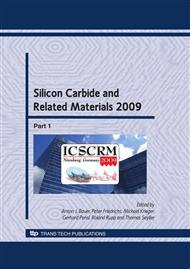p.251
p.255
p.259
p.263
p.267
p.271
p.277
p.283
p.287
Elastic Properties of Dense Organosilicate Glasses Dependent on the C/Si Ratio
Abstract:
Organosilicate glasses (OSG) are of great technological interest as low-k dielectrics. We use ab initio simulations to analyze the influence of the C/Si ratio in OSG on the density and elastic properties of pore-free material to gain a detailed understanding of the origins of these properties in this class of materials. We find that the addition of carbon to amorphous silica leads to a stiffening of the material by removing the bending degrees of freedom of Si-O-Si bonds. This transition in mechanisms of stiffness, leads to a distinctly nonlinear behavior of the bulk and elastic modulus over the C/Si ratio. Experimental results do not contradict our findings, however dominant pore effects impede conclusive comparison.
Info:
Periodical:
Pages:
267-270
Citation:
Online since:
April 2010
Authors:
Keywords:
Price:
Сopyright:
© 2010 Trans Tech Publications Ltd. All Rights Reserved
Share:
Citation:


